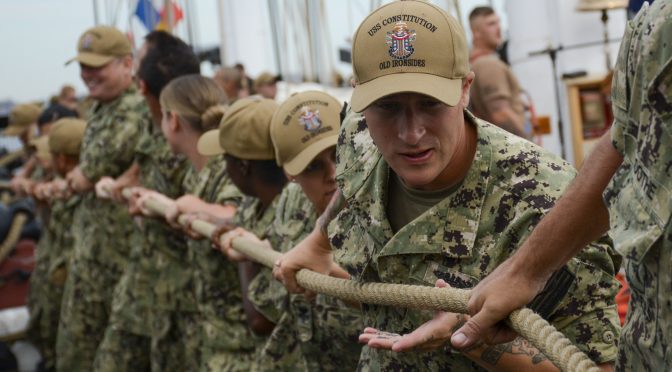Notes to the New CNO Topic Week
By Lieutenant Zachary George, USN
Over the last 18 years, the Navy Reserve has served as the nation’s third land army, filling gapped Army billets in the War on Terror in the Middle East and Africa. Through its Expeditionary Combat Readiness Centers (ECRC) in Norfolk and San Diego, it has perfected the art of making Navy Sailors into soldiers. This includes stripping Sailors of their coveralls and giving them a sea bag’s worth of combat helmets, flak jackets, and desert boots, after which, they are sent to Fort Jackson, South Carolina for three weeks of basic soldiering skills. As the Navy actively contests a resurgent Russia and an emerging China, both EUCOM and PACOM are calling for more Naval Reservists to fill sea billets, ensuring special missions and regular warships are fully manned and ready. Unfortunately, the ECRCs are not ready for this shift, being unable to send reserve Sailors back through fleet damage control trainers or even issuing them required firefighting coveralls. While the rest of the fleet is shifting to the high-end fight, it’s time for the CNO to radically change the ways the Navy sources, trains, equips, and sends out reserve Sailors to sea-going mobilizations.
Unlike the reserve naval aviation component that still operates and maintains actual combat and logistical aircraft, the reserve surface force decommissioned all of its reserve ships in the late 1990s, leaving coastal riverine squadrons as their only platforms. While some experience and in-rate training can be gained on small boats, those rates, such as Operational Specialists, Sonar Technicians, Electronics Technicians, require hands-on experience on the advance and complex systems found only on warships. Additionally, some reserve sailors in sea-going rates are pure reservists with no sea time, so they are have zero training outside boot camp in damage control and shipboard organization. Some might not know how to even read a ship’s bullseye, a placard that explains how to navigate a ship’s interior.
The solutions? First, add a maritime training week to ECRC after the initial administrative week. This week would include ship tours, wet/fire trainers, and classes about the 3M preventative maintenance system. Next, accelerate and expand the “Reserve Component to Sea Initiative” by shutting down large headquarters reserve units and instead, man the fleet. This ensures that the Sailors drill and train when not mobilized with their active duty brothers and sisters, and can squeeze into fleet training and specialized courses when available. This shift allows reservists to mobilize with their shipmates, vice just showing up to ECRC and then deploying to a thrown-together military detachment with no training or zero workup time.
It is time again to get the reserves back to sea. The CNO must direct the Chief of the Navy Reserve and the Chief of Naval Personnel to quickly make both the Reserve Surface Force and the greater global force management process a system that mobilizes Sailors into Sailors, and not Sailors into soldiers.
Lieutenant Zac George is a reserve surface warfare officer, currently mobilized as the Military Detachment Assistant Officer-in-Charge onboard USNS YUMA (T-EPF 8) in SIXTH FLEET.
Featured Image: BOSTON (Aug. 23, 2019) Chief petty officer selects, Sailors who have been selected for the paygrade of E-7, come together for Chief Heritage weeks aboard the oldest commissioned warship afloat in the world, USS Constitution. (U.S. Navy Photo by Mass Communication Specialist 3rd Class Casey Scoular/Released)190823-N-SM577-0053


Uhm, ok – I was a Navy Seabee as a Reservist…
Adding a maritime week to ECRC is good first aid for a self-inflicted wound: better than nothing, but a less effective than avoiding the initial injury.
Where the Navy keeps hurting itself is the failure to link Reservists and their mobilizations with actual fleet units and skills. Most NR units are linked to headquarters commands if they are linked to anything and serve only to keep Sailors mobilization-ready (medical, dental, GMTs complete) for individual augment-type orders. Most of these mobilizations seem to go to rear-echelon jobs overseas where the Reservist’s prior military and civilian experience don’t matter much, since they’re more likely to be operating a PC on a watchfloor than any Navy fleet hardware. Were fleet units to actually need trained operators or maintainers with any level of currency, they’d have to steal from training commands because the Reserves wouldn’t be much help.
How about bring back the draft?
A universal service where everyone servers?
This is not new but must have expanded to a broader scope than what I experienced in 86 when I discharged from active duty. I was out a month or two joined the reserves at then NAS Dallas in Grand prairie Texas. Being a Boiler Technician they absolutely did not know what to do with me. Initially I was attached to a reserve unit they called NAS Miramar. They mustard in the walk in theater on base… Honestly and looked at me as if I was an alien. I was told to report to MAA/Base police on my second drill day. I sat in their “office area” with everyone else and occasionally rode with another reserve member in a Dodge K Car to enforce traffic over a few drill weekends… Long story short I quit! Kinda sad because I was going to try and change rate and reenlist and go back to active duty. When I tried to talk to a Chief about my future I was told shut up and roll with it or he would “send my ass to the fleet”. He literally knew nothing about me or my service before trying to shut me up and put this lowly third class PO in his place. I had already served 4 years 6 months active duty all sea time. Ineptness is nothing new for the Navy!